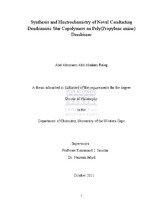| dc.description.abstract | One of the most powerful aspects of conducting polymers is their ability to be nanostructured through innovative, synthetically manipulated, transformations, such as to tailor-make the polymers for specialized applications. In the exponentially increasing wide field of nanotechnology, some special attention is being paid to innovative hybrid dendrimer-core based polymeric smart materials. Star copolymers are a class of branched macromolecules having a central core with multiple linear polymer chains extending from the core. This intrinsic structural feature yields a unique 3D structure with extended conjugated linear polymer chains, resulting in star copolymers, which have higher ionic conductivities than their corresponding non-star conducting polymer counterparts. In this study an in-depth investigation was carried out into the preparation and characterization of specialized electronic smart materials. In particular, the preparation and characterization of novel conducting dendrimeric star copolymers which have a central poly(propylene imine) (PPI) dendrimer core with conducting polypyrrole (PPy) chains extending from the core was carried out. This involved, first, the preparation of a series of dendrimeric polypyrrole poly(propylene imine) star copolymers (PPI-co-PPy), using generations 1 to 4 (G1 to G4) PPI dendrimer precursors. The experimental approach involved the use of both chemical and electrochemical synthesis methods. The basic procedure involved a condensation reaction between the primary amine of a diamino functional PPI dendrimer surface and 2-pyrrole aldehyde, to afford the pyrrole functionalized PPI dendrimer (PPI-2Py). Polymerization of the intrinsically contained monomeric Py units situated within the dendrimer backbone was achieved via two distinctly different routes: the first involved chemical polymerization and the second was based on potentiodynamic oxidative electrochemical polymerization. The star copolymers were then characterized using various sophisticated analytical techniques, in-situ and ex-situ. Proton nuclear magnetic resonance spectroscopy (1HNMR) and Fourier transform infrared spectroscopy (FTIR) were used to determine the structures. Scanning electron microscopy (SEM) was used to determine the morphology. Themogravimetric analysis (TGA) was used to study the thermal stability of the prepared materials. X-ray diffraction analysis (XRD) was used to study the structural make-up of phases, crystallinity and amorphous content. Hall effect measurements were carried out to determine the electrical conductivity of the chemically prepared star copolymers. The PPI-co-PPy exhibited improved thermal stability compared to PPI-2Py, as confirmed by TGA. SEM results showed that the surface morphology of the functionalized dendrimer and star copolymer differed. The surface morphology of the chemically prepared star copolymers resembled that of a flaky, waxy material, compared to the ordered morphology of the electrochemically grown star copolymers, which resembled that of whelk-like helixes. In the case the electrochemically grown star copolymers, SEM images recorded at higher magnifications showed that the whelk-like helixes of the star copolymers were hollow tubes with openings at their tapered ends, and had an average base diameter of 2.0 mu;m. X-ray diffraction analysis of the first generation star copolymer G1PPI-co-PPy revealed a broadly amorphous structure associated with PPy, and crystalline peaks for PPI. Cyclic voltammetry (CV), square wave voltammetry (SWV) and electrochemical impedance spectroscopy (EIS) techniques were used to study and model the electrochemical reactivity of the star copolymer materials. Electrochemical impedance spectroscopy data showed that the G1PPI-co-PPy exhibited slightly higher ionic conductivity than pristine PPy in lithium perchlorate. The second generation star copolymer G2PPI-co-PPy electrochemically deposited on a platinum (Pt) electrode had a lower electrochemical charge transfer resistance compared to electrodeposited polypyrrole (PPy) on a Pt electrode, and bare Pt. The decrease in charge transfer resistance was attributed to an increase in the conjugation length of the polymer as a result of the linking of the highly conjugated PPy to the PPI dendrimer. Bode impedimetric analysis indicated that G2PPI-co-PPI was a semiconductor, with a maximum phase angle shift of 45.3° at 100 MHz. The star copolymer exhibited a 2- electron electrochemistry and a surface coverage of 99%. Results of Hall effect measurements showed that the star copolymer is a semiconducting material, having a conductivity of 0.7 S cm-1, in comparison to the 1.5 S cm-1 of PPy. To the best of my knowledge, these new star copolymers have not been reported in the open literature. Their properties make them potentially applicable for use in biosensors. | en_US |

